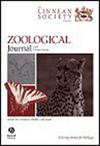Phylogenomics of Characidae, a hyper-diverse Neotropical freshwater fish lineage, with a phylogenetic classification including four families (Teleostei: Characiformes)
IF 3
2区 生物学
Q1 ZOOLOGY
引用次数: 0
Abstract
Neotropical tetras of the family Characidae form the largest and most taxonomically complex clade within the order Characiformes. Previous phylogenetic relationships concur on the recognition of four major subclades, whereas knowledge on intergeneric and interspecific relationships remains largely incomplete or nonexistent. We sampled 575 specimens of 494 species and 123 genera classified in Characidae, generated new molecular data of ultraconserved elements (UCEs), and used likelihood and Bayesian analyses. The phylogeny (1348 UCE loci: 538 472 bp) yielded clades with unprecedented resolution at species- and genus-levels, allowing us to propose a new classification of former Characidae into four families: Spintherobolidae, Stevardiidae, Characidae, and Acestrorhamphidae. The family Stevardiidae includes nine subfamilies: Landoninae, Xenurobryconinae, Glandulocaudinae, Argopleurinae, Hemibryconinae, Stevardiinae, Planaltininae, Creagrutinae, and Diapominae. The family Characidae includes five subfamilies: Aphyocharacinae, Cheirodontinae, Exodontinae, Tetragonopterinae, and Characinae. The family Acestrorhamphidae congregates 15 subfamilies: Oxybryconinae, Trochilocharacinae, Stygichthyinae, Megalamphodinae, Stichonodontinae, unnamed subfamily, Stethaprioninae, Pristellinae, Jupiabinae, Tyttobryconinae, Hyphessobryconinae, Thayeriinae, Rhoadsiinae, Grundulinae, and Acestrorhamphinae. The phylogeny resolves intergeneric relationships and supports revalidation of Myxiops, Megalamphodus, Ramirezella, Holopristis, and Astyanacinus, synonymy of Aphyodite, Genycharax, and Psellogrammus, and expansion of Cyanogaster, Makunaima, Deuterodon, Hasemania, Hemigrammus, Bario, Ctenobrycon, and Psalidodon. The phylogeny opens avenues for new systematic reviews and redefinitions of included genera.胭脂鱼科的系统发生组学--一个超级多样化的新热带淡水鱼系,包括四个科的系统发生分类(远洋鱼类:胭脂鱼形目)
胭脂鱼科的新热带四大家鱼是胭脂鱼目中最大、分类最复杂的支系。以往的系统发育关系一致认为有四个主要的亚支系,而关于属间和种间关系的知识仍然很不完整或不存在。我们采集了胭脂鱼科 494 个种和 123 个属的 575 个标本,生成了新的超保守元素(UCE)分子数据,并使用似然法和贝叶斯法进行了分析。系统进化(1348 个 UCE 位点:538 472 bp)得出的支系在种级和属级上具有前所未有的分辨率,使我们能够提出将前胭脂鱼科分为四科的新分类:Spintherobolidae、Stevardiidae、Characidae 和 Acestrorhamphidae。Stevardiidae 科包括 9 个亚科:Landoninae、Xenurobryconinae、Glandulocaudinae、Argopleurinae、Hemibryconinae、Stevardiinae、Planaltinae、Creagrutinae 和 Diapominae。胭脂鱼科包括五个亚科:Aphyocharacinae、Cheirodontinae、Exodontinae、Tetragonopterinae 和 Characinae。Acestrorhamphidae 科包括 15 个亚科:Oxybryconinae, Trochilocharacinae, Stygichthyinae, Megalamphodinae, Stichonodontinae, unnamed subfamily, Stethaprioninae, Pristellinae, Jupiabinae, Tyttobryconinae, Hyphessobryconinae, Thayeriinae, Rhoadsiinae, Grundulinae 和 Acestrorhamphinae。该系统发育解决了属间关系问题,并支持对 Myxiops、Megalamphodus、Ramirezella、Holopristis 和 Astyanacinus 的重新鉴定,Aphyodite、Genycharax 和 Psellogrammus 的同义,以及 Cyanogaster、Makunaima、Deuterodon、Hasemania、Hemigrammus、Bario、Ctenobrycon 和 Psalidodon 的扩展。该系统发育为新的系统综述和重新定义所包括的属开辟了道路。
本文章由计算机程序翻译,如有差异,请以英文原文为准。
求助全文
约1分钟内获得全文
求助全文
来源期刊
CiteScore
6.50
自引率
10.70%
发文量
116
审稿时长
6-12 weeks
期刊介绍:
The Zoological Journal of the Linnean Society publishes papers on systematic and evolutionary zoology and comparative, functional and other studies where relevant to these areas. Studies of extinct as well as living animals are included. Reviews are also published; these may be invited by the Editorial Board, but uninvited reviews may also be considered. The Zoological Journal also has a wide circulation amongst zoologists and although narrowly specialized papers are not excluded, potential authors should bear that readership in mind.

 求助内容:
求助内容: 应助结果提醒方式:
应助结果提醒方式:


